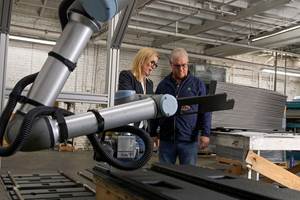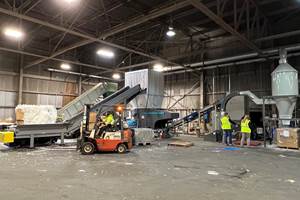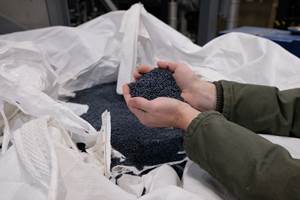Processor Turns to AI to Help Keep Machines Humming
At captive processor McConkey, a new generation of artificial intelligence models, highlighted by ChatGPT, is helping it wade through the shortage of skilled labor and keep its production lines churning out good parts.
The North American plastics processing market has a long-standing and justifiable reputation for being conservative when it comes to implementing new technology. Apparently, McConkey Company didn’t get the message. The third-generation-owned processor recently turned to artificial intelligence (AI) as a way to replace the tribal knowledge lost when older-generation technicians retired.
Based in at 72,000 ft2 plant in Sumner, Wash., McConkey makes pots, containers, planters and other products for the horticultural industry, mostly under its own label. It runs nine injection presses, three thermoformers and a sheet extrusion line. The problem it was facing is typical across manufacturing: skilled senior technicians retiring, those who haven’t yet but have one foot out the door, and a new generation of younger technicians in short supply.
Plastics processors have typically responded with documentation and training, notes Derek Moeller, founder of CognitionWorks, a company that develops expert AI systems for the manufacturing industry. In this process, production managers and process engineers write up standardized processes, and then supervisors train floor staff on those procedures. But there are two problems that actual practitioners face.
Dusty Binder Problem
One is what Moeller has dubbed the “dusty binder problem.” He elaborates, “First, manufacturing has so many processes and edge cases, it’s hard to make them all accessible to employees when and where they need them. Yes, the process is documented, in that binder up on the shelf, or uploaded to some file system. But it doesn’t always work in reality. An extruder goes down at 2 a.m. with a fault code on a VFD, and the technician on duty has been there six months. And, while it’s not the first time this has happened, it’s been a year since it last occurred.”
Moeller continues, “Is that binder getting opened at 2 a.m. when a machine has a fault? Does the technician know where to find the procedure? Do they know the problem happened before? Do they know what the solutions are? Or will the technician make a couple of attempts to fix it based on their best guess, and then leave it down until someone more experienced shows up for day shift?”
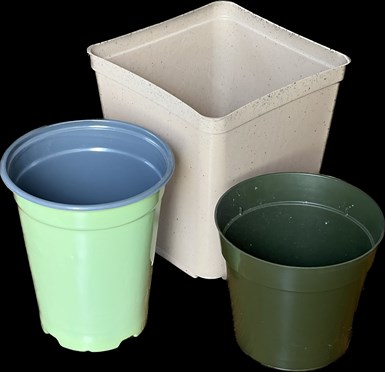
McConkey serves the horticultural market with a range of molded and thermoformed pots, containers, planters and other products. Photos: McConkey Co.
The second problem is job tenure, according to Moeller, and it exacerbates the first problem. “According to the Bureau of Labor Statistics, manufacturing employees in the 24-35 age category only stay in their jobs for an average of 2.9 years. Compare that to the 55-64 age category, with an average tenure of 10 years. Good news for recruiters, bad news for employers: the tenure problem is going to get worse.”
In response, Moeller notes managers train new employees, but 12-18 months later many of them have left. Even with great documentation and training, that leaves little time for new employees to be effective before they’ve left again.
What’s Generative AI?
Just six months ago, the AI company OpenAI released a product called ChatGPT. Moeller says it’s arguably been the most popular launch of a new product in history, with more than 100 million new users within a few months. “This system — the GPT stands for “Generative Pretrained Transformer” — has hundreds of billions of neurons and is trained on trillions of words from the Internet and books,” he says.
Explains Moeller, “What does ChatGPT do? Simply, write text. People are using it in all sorts of ways. Marketers use it to write blog posts. Students use it to write essays. People ask it to write recipes, emails and letters.
“ChatGPT’s ability to write and reason in a surprisingly human way is startling, especially with the latest, biggest model, called GPT-4, in which Microsoft researchers said they found ‘sparks of artificial general intelligence,’” Moeller adds, meaning human-level intelligence.
Artificial Intelligence in Plastics
At first, language-based AI systems like ChatGPT may not seem at home in a plastics processing facility. But Moeller says they are remarkably good at finding, processing and summarizing information for people, which has been precisely McConkey’s experience.
“We turned to CognitionWorks to develop an AI system that could provide advice and help to employees in the form of an AI chat assistant, and that relied on the manuals, troubleshooting guides and prior maintenance logs to make recommendations,” recalls Stina McConkey, the company’s COO.
McConkey wanted technicians to be able to query this large body of knowledge and get actionable answers back, without sorting through binders or shared drives.
As McConkey recalls, the company had three objectives. First, McConkey had tens of thousands of technical documents, troubleshooting guides and repair logs going back more than 10 years. It wanted technicians to be able to query this large body of knowledge and get actionable answers back, without sorting through binders or shared drives.
Second, it wanted it to be very easy to use. Says Stina McConkey, “It had to use natural language, so a technician could text, as though they were texting a friend, messages like ‘I’m not building enough pressure on injection line 8, how do I fix it?’ and get helpful, well-organized information back. We use Microsoft Teams, and we wanted to chat with the AI assistant as if it were another colleague.”
Third, Stina McConkey also wanted the system to be able to intelligently answer questions for company management. “I wanted to easily get a summary of production from the previous day — and the major issues — by production line, without having to log into a production record-management system and scroll through all the database entries.”
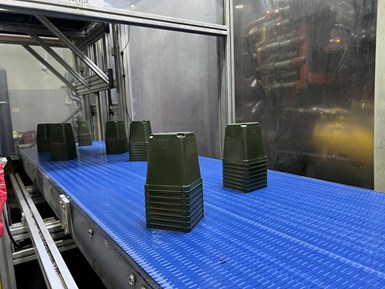
Horticultural pots conveyed from one of McConkey’s nine injection molding machines.
To do all his, Moeller says CognitionWorks created an integrated system, driven by a trained AI language model, that could interact with the company’s existing work order tracking system, and ingest all the prepared manuals, procedure books and other documentation.
“And we threw everything at it: scanned equipment manuals, tens of thousands of work orders, PowerPoint presentations of procedures, Word documents, tool setup sheets,” says Stina McConkey. “We even taught it to use the company’s production record database, which it interfaced to using the database language SQL, a language the AI naturally ‘speaks.’”
A New Colleague Is Born
Then the new system was switched on. Immediately, McConkey says the tool showed its promise: “It had an uncanny ability to structure actionable steps, via a chatbot, after it found work orders that were sometimes years old but relevant to the problem at hand,” she says.
Maintenance mechanics could ask about a fault error they saw and get a concise summary of possible causes, compiled from machine manuals and maintenance logs, in about 15 seconds. Injection molding process technicians could ask about a product defect they saw, and 20 seconds later get an answer on how to correct it, based on the company’s prior knowledge. And production managers could get fast summaries of problems recorded by production teams over preceding shifts.
Even those with decades of experience at the company found it useful because it would “remember” older events that were relevant to the question at hand and, instead of thinking about the top one or two possible causes, the AI suggested seven or more for the team to consider.
Injection molding process technicians could ask about a product defect they saw, and 20 seconds later get an answer on how to correct it, based on the company’s prior knowledge.
Limits of AI
There were limitations to what the new AI colleague (which the team affectionately calls ‘Sprocket’) could do. The main one, Stina McConkey recalls, was when there wasn’t relevant documentation. If a problem is novel, an AI will not typically be successful at reasoning through to an unknown solution.
The good news, according to Moeller, is that adoption of these tools will give a leg up to plastics processors that have already been diligent with documentation. He elaborates, “Their existing assets — whether it be manuals, procedure documents, repair logs, regulatory documents or similar — will simply become vastly more valuable and effective, and enable these companies to fix machines faster, provide faster service to customers, become less reliant on any individual expert and make new employees productive much faster than those companies that don’t have the same existing data. This will also make process engineers and anyone who writes documentation more valuable, because their work will be used to train AI assistants to support front line employees.”
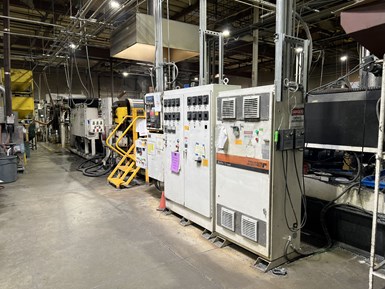
On sheet extrusion lines like this and other processing equipment, companies that will benefit the most from AI are those that have kept manuals, documents, repair logs and the like up to date.
He adds, “Secondly, they will make employees much more productive — imagine any employee being able to casually chat with an AI that has the totality of every documented piece of history in your company in its brain — but they will not replace team employees who innovate and develop new ideas. That’s human territory.
The Security Conundrum
For many processors and other manufacturers, their internal procedures are trade secrets and it’s vital this data stays private. Moeller says the AI industry has recognized this necessity and responded in two ways. OpenAI, currently the company with the biggest language models, has contractually agreed to not retain or train on any data submitted through its API.
“For most companies, that will be good enough,” he says. “For some companies in sensitive industries, stricter security is required. Amazon and Azure, the two leading cloud server providers, can host a separate instance of advanced large language models from other companies (including Anthropic, A21 Labs and Cohere) in an encrypted and secure virtual private cloud, so that no data ever leaves the manufacturer’s private cloud, and it is impossible for data to be retained. Naturally, the complexity of these implementations is higher, but it’s a good solution for companies with legal requirements for it.
Related Content
Wisconsin Firms Unite in Battle Against Covid
Teel Plastics opened new plant in record time, partnering with AEC & Aqua Poly Equipment Co. to expand production of swab sticks to fight pandemic.
Read MoreCobot Creates 'Cell Manufacturing Dream' for Thermoformer
Kal Plastics deploys Universal Robot trimming cobot for a fraction of the cost and lead time of a CNC machine, cuts trimming time nearly in half and reduces late shipments to under 1% — all while improving employee safety and growth opportunities.
Read MorePurpose-Built System Enhances Capacity and Flexibility for Recycler
A Boston recycler invested in a turnkey shredding, granulation and elutriation system to expand its plastics reclaim business.
Read MoreNew Facility Refreshes Post-Consumer PP by Washing Out Additives, Contaminants
PureCycle prepares to scale up its novel solvent recycling approach as new facility nears completion.
Read MoreRead Next
Why (and What) You Need to Dry
Other than polyolefins, almost every other polymer exhibits some level of polarity and therefore can absorb a certain amount of moisture from the atmosphere. Here’s a look at some of these materials, and what needs to be done to dry them.
Read MoreProcessor Turns to AI to Help Keep Machines Humming
At captive processor McConkey, a new generation of artificial intelligence models, highlighted by ChatGPT, is helping it wade through the shortage of skilled labor and keep its production lines churning out good parts.
Read MoreHow Polymer Melts in Single-Screw Extruders
Understanding how polymer melts in a single-screw extruder could help you optimize your screw design to eliminate defect-causing solid polymer fragments.
Read More.png;maxWidth=970;quality=90)

















.png;maxWidth=300;quality=90)






